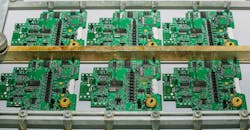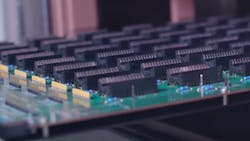How the CHIPS and Science Act Will Benefit Fluid Power and Motion Control Manufacturers
On August 9, U.S. President Joe Biden signed the CHIPS and Science Act into law. The bill had previously received bipartisan support, passing both the House and Senate in late July.
Through this new legislation, over $200 billion will be invested over the next 5 years to benefit U.S. manufacturing — particularly for semiconductor chips as well as scientific research. This will help to create more jobs and improve the domestic supply of goods.
READ MORE from our colleagues at Industry Week:
Global Chip Shortage Likely to Last Through 2023: US Official
Supply chains continue to present challenges for many industries, with semiconductors being one of the most notable examples. These small electronic components have become a vital part of many goods from consumer electronics to passenger cars to heavy-duty trucks and equipment.
Manufacturers of all types have felt the impacts of the semiconductor shortage. Automotive manufacturers, for example, have had to delay production of many vehicles while waiting to receive the necessary supply of chips leading to the current spikes in car prices and limited availability. Volvo Group announced in March 2021 it would implement stoppage days across its global truck manufacturing facilities due the inability to get the semiconductor chips it needed.
These pauses in manufacturing often then lead to impacts on the various component manufacturers who supply the OEMs such as fluid power and motion control developers.
Some component suppliers have also noted impacts on their own activities. One company executive in the fluid power industry told this author at a conference that his engineers were having to rethink how they went about designing certain products, sometimes reverse engineering them, because the company could not get the semiconductors they would otherwise use.
But by passing the new CHIPS bill, President Biden is hoping to alleviate these issues and bolster U.S. manufacturing — a key goal for his administration.
Increased Semiconductor Chip Manufacturing
The CHIPS and Science Act will provide $52.7 billion for research, development, manufacturing, and workforce development related to semiconductor chips in the U.S. Funding includes manufacturing incentives as well as tax credits, aiding the establishment of production facilities.
Included in the new law are stipulations on how the funds can be used to ensure companies do not set up operations in China or other countries of concern.
Over the last several years, manufacturing of semiconductors—like many other products—has been outsourced to other countries such as China. Per a White House fact sheet on the new law, the U.S. currently produces about 10% of the world’s supply of semiconductor chips while East Asia produces 75%.
However, the new law aims to help make it easier for companies to establish semiconductor chip manufacturing facilities in the U.S. This will increase domestic supply, making it faster and easier for manufacturers to get the components they need. It will also help to create new jobs, benefitting people and the economy.
According to the White House fact sheet, companies have announced close to $50 billion in additional investments in semiconductor manufacturing in the U.S. upon passage of the new law.
After the passage of the bill by the U.S. House of Representatives, Kip Eideberg, senior vice president of government and industry relations for the Association of Equipment Manufacturers (AEM), released a statement noting the positive reaction of the heavy equipment manufacturing industry.
“For years, we have watched family sustaining jobs leave our country, but with this historic, bipartisan investment in U.S.-made semiconductor production, equipment manufacturers are now poised to invest in their workers and communities, drive innovation, and strengthen America’s long-term economic competitiveness and national security,” said Eideberg. “According to a new survey, 7 in 10 equipment manufacturing CEOs said that the bill will allow them to create more jobs in America. Equipment manufacturers rely on a robust and reliable supply of semiconductors to make world-class equipment here in America, and we applaud Congress for passing this important bill.”
Fluid power and motion control manufacturers will benefit as well from the new legislation. New investments in manufacturing facilities will lead to increased demand for the machines utilized within them, many of which use hydraulics, pneumatics, and motion control components.
As the new semiconductor manufacturing facilities come online, chip production will increase and make these components more readily available to various OEMs who will be able to increase their own production capacities as well. This will lead to further demand for fluid power and motion control components.
Construction and agricultural equipment, for instance, are key segments for the hydraulics industry. If heavy equipment OEMs can increase their production of these machines, there will be greater demand for products from hydraulic component manufacturers.
READ MORE: Mobile Hydraulics Market Rebound in 2021 Leads to Positive Future
New Investments in Scientific Research
Close to $170 billion of the funding provided by the CHIPS and Science Act will be dedicated to scientific research, innovation, and space exploration. Much of this will go through the National Science Foundation (NSF) and the U.S. Department of Energy’s Office of Science.
By investing in science and technology, the Biden administration aims to enable innovation that will then stay and be produced in the U.S. Doing so will help keep the country competitive in the global market as well as provide jobs and benefit the economy.
The White House fact sheet states areas of focus for the NSF funding include:
- semiconductors and advanced computing,
- advanced communications technology,
- advanced energy technologies,
- quantum information technologies, and
- biotechnology.
All of these areas of focus will be important to the advancements being made in various industries such as the use of automation in manufacturing and electrification of vehicles—both of which are growing areas of importance for fluid power and motion control manufacturers.
Funding from the bill will go towards creation of regional innovation and technology hubs as well as STEM (science, technology, engineering, and mathematics) activities for both education and workforce development.
The latter will benefit many industries, including fluid power and motion control, which are finding it difficult to attract younger generations. The White House fact sheet states the new bill authorizes new and expanded investments in STEM education and training from K-12 to community college, undergraduate and graduate education. There will also be initiatives to diversify the research institutions, communities and schools which receive STEM funding to ensure a broader pool of potential talent is reached and innovation supported.
READ MORE: How do We Shape the Future Workforce?
With the investments that will be made through the CHIPS and Science Act, a variety of industries are likely to benefit and help bring about more innovation and manufacturing in the U.S.
About the Author
Sara Jensen
Executive Editor, Power & Motion
Sara Jensen is executive editor of Power & Motion, directing expanded coverage into the modern fluid power space, as well as mechatronic and smart technologies. She has over 15 years of publishing experience. Prior to Power & Motion she spent 11 years with a trade publication for engineers of heavy-duty equipment, the last 3 of which were as the editor and brand lead. Over the course of her time in the B2B industry, Sara has gained an extensive knowledge of various heavy-duty equipment industries — including construction, agriculture, mining and on-road trucks —along with the systems and market trends which impact them such as fluid power and electronic motion control technologies.
You can follow Sara and Power & Motion via the following social media handles:
X (formerly Twitter): @TechnlgyEditor and @PowerMotionTech
LinkedIn: @SaraJensen and @Power&Motion
Facebook: @PowerMotionTech

Leaders relevant to this article:



